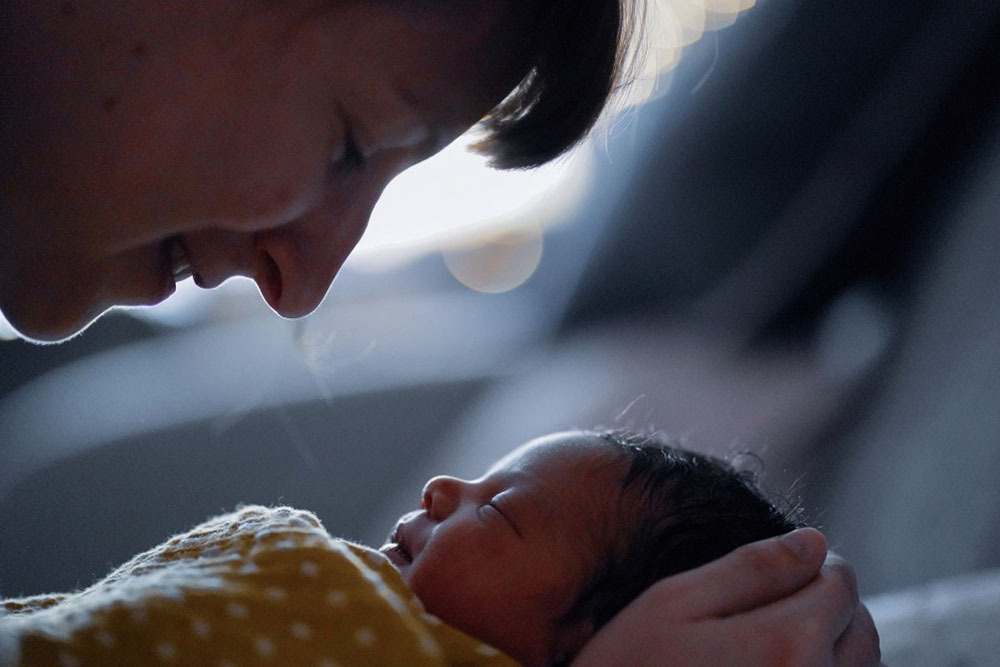Good Sleep Habits From the Start

Worried that your newborn won’t sleep? There’s no magic formula, but these sleep tips will hopefully give you some rest and reassurance.
Expert Source: Lisa Erbes, MEd; Amy Magneson, MD, FACOG; Elizabeth Pantley
If one thing is universally true about caring for a newborn, it’s that the proud parents will be enduring some severe sleep deprivation. Although babies snooze a lot (we’re talking 16 or so hours a day early on), they also wake frequently and with several pressing needs, such as hunger, requiring a diaper change, or seeking comfort.
Along with the new parents’ expected lack of Zs comes a sort of unexpected sleep naiveté. Is my baby getting enough rest? Where should they sleep? What time should they go to bed? When do I begin a bedtime routine? What is “sleep training”? What about SIDS?
Tired to the bone and confused by the massive amounts of infant sleep information out there—much of it presenting contradictory points of view—parents often feel they’re getting it wrong. But it’s important to remember that each family has different sleep patterns and needs. Establishing good habits is important, but whatever gets the entire family the best rest safely is the overall goal.
Sleep Parenting vs. Sleep Training
We live in a world of convenience. Answers to every question and solutions to everyday problems are seemingly at our fingertips; we can order groceries online and see them at our doorstep before dinner. This instant gratification of modern times has even trickled down to how we view infant sleep. “Is your baby sleeping through the night yet?” has been a common question for many years, but recent generations of parents have come to seek solutions to the so-called “sleep problem” of night-waking.
“Sleep training” is a term that loosely covers many areas of parenting thought, such as Cry it Out (or CIO) or the Ferber Method, which both mean the same thing: letting baby cry for some time with a goal of teaching them to self-regulate, self-soothe, and sleep for longer stretches through the night.
Some parents swear by a certain form of sleep training, but for others, it comes with a level of guilt, misgiving, or confusion. “My biggest regret in terms of sleep was the day I let my partner talk me into letting our son cry it out,” says Suzanne Thompson, a mother from Sacramento, California. “My sweet baby had cried so hard he vomited and then fell asleep in it. I’ve never actually admitted that before. It is still a huge source of shame and guilt for me, and needless to say, I never let it happen again.”
Parents often speak of crying themselves while incorporating CIO methods and recall “staying strong” on the other side of the closed nursery door. Why is this? Simply put, we are biologically wired to go to our baby—no matter how exhausted or frustrated we might be. Ignoring those cries goes against instinct and, in turn, raises the cortisol—or stress hormone—levels in both the parent and the child.
That’s not to say that it can’t work, and it’s certainly not to say that older babies can’t handle some independent fussing with nighttime sleep boundaries set by the parents. Experimenting with a reduction in soothing time and a wait-and-see initiative upon the first cry is known as “sleep parenting.”
Sleep parenting keeps the parent-child connection and the baby’s needs in mind. The term highlights the fact that parents are caregivers 24 hours a day. Children—babies in particular—might have middle-of-the-night needs that may be inconvenient to a parent, but they should still respond to those needs.
Understanding Your Child’s Sleep
Such an essential piece in understanding infant sleep is the realization that every baby is different. Some sleep characteristics are universal, but most are unique to the individual.
Consider the adults you know. Chances are you’ve encountered “night owls” and “morning people,” light and deep sleepers. Some of your friends may need 10 hours of sleep to feel sane, while others can cruise through the day energetically on a solid six and a half. Babies, too, have their own sleep characteristics.
“Temperament is the biggest factor in how babies sleep,” says Lisa Erbes, MEd, parent and family educator, lactation counselor, and infant sleep consultant in Apple Valley, Minnesota. “You cannot change your baby’s temperament, but you can change how you respond to your child’s particular sleep needs.”
An example of adjusting to your baby’s temperament would be the evening routine: Most babies love baths, and many respond to that activity by relaxing. However, some babies are easily overstimulated. For those infants, baths might be playful and exciting—which means it’s not a good idea to bathe just before bedtime. This kind of discovery, of course, comes from trial and error. By getting to know your newborn and respecting their temperament, you will be able to create an appropriate bedtime routine and get more rest.

How To Establish a Bedtime Routine
Here’s the cold-hard truth: You should expect your baby to wake frequently during the day and night. “A newborn’s brain does not make sleep hormones. Their sleep patterns are driven by one thing … getting fed,” Erbes explains. “How long they sleep depends on how long it takes to eat, digest, and become hungry again.” In other words, it’s personal—and perfectly normal.
Erbes points out, “The definition of sleeping through the night, for an infant, is five consecutive hours after midnight.” That’s right: five hours.
With your expectations in check, you can start establishing a simple routine that lets your little one know that it’s time to rest. Examples of routine building blocks might include:
- Bathing
- Massaging
- Singing softly
- Reading a story or singing a lullaby
- Quieting the house
- Dimming the lights
Amy Magneson, MD, FACOG in Mount Kisco, New York, recommends parents begin this process sooner rather than later: “Do it early! Start establishing a newborn sleep routine right when they get home—a routine of where they sleep, what their naptimes are, and what their bedtime is. They may not stick to it right away—and that’s OK—but if the framework is there, it will make things so much easier.”
A Consideration for Co-sleeping
The American Academy of Pediatrics (AAP) endorses room-sharing but not bed-sharing. However, some pediatric studies show a decrease in the risk of SIDS when bed-sharing is done correctly, intentionally, and between an exclusively breastfeeding parent and their child. In fact, James McKenna, PhD, the renowned Notre Dame University anthropologist and longtime advocate of proximal sleeping between birth parent and child, and his colleague Lee Gettler, PhD, advocate for the use of a new word: “breast-sleeping.”
“Our baby sleeps in bed with us and [nurses] whenever she is hungry. This is standard in many countries but not always accepted in the U.S.,” says Jesse Oquist, a father of three in McKinney, Texas. “Some mothers have said that they can’t get enough sleep when the baby has an open buffet, but my wife wouldn’t be able to sleep any other way.”
La Leche League International also encourages this practice of bed-sharing. They emphasize their resource, The Safe Sleep Seven. All criteria on the list should be met (for baby and the birth parent) before considering bed-sharing, without exception:
- Birth parent is a nonsmoker
- Birth parent is sober and unimpaired
- Birth parent is breastfeeding
- Baby is healthy and full-term
- Baby is on their back
- Baby is lightly dressed
- Birth parent and baby are both on a safe surface
If bed-sharing seems too risky, you can still make the most out of room-sharing. Elizabeth Pantley, author of The No-Cry Sleep Solution: Gentle Ways to Help Your Baby Sleep Through the Night, says co-sleeping “allows parents to closely monitor their infant all night long. And [because] their baby is close by, they can get more sleep than if they’re worrying about the little one who is in another room.”
Rooming with your newbie doesn’t just potentially help you catch more Zs (now that you don’t have to go across the hall for every night feeding), but it also bolsters your bond with baby because they’ll quickly learn you’re there if they need you. Pantley says room-sharing should incorporate the following three key factors to be successful:
Keep baby close
Your tiny snoozer should be near enough to wake you if they stir or make a peep. Place baby nearby in a crib or bassinet, or consider a sidecar arrangement where a co-sleeping device sits directly beside the main bed. This way, you can see and touch baby while keeping them out of your bed.
Ensure a safe sleep environment
Baby’s bed should comply with U.S. Consumer Product Safety Commission standards—make sure that the mattress is flat, firm, and smooth, that the fitted sheet stays secure, and that there are no crevices baby could be wedged in.
Be continuously flexible
As your tot (and perhaps your family) grows, sleeping arrangements will transform during the first year. (Hello, four-month sleep regression and many, many milestones!) Pantley’s advice is to stay aware of everyone’s needs, make thoughtful decisions, and try to go with the flow. Don’t beat yourself up for needing to pivot or for entering survival mode for a period when necessary. You’re doing the best you can!
There’s plenty to consider when it comes to infants and sleep, but if there’s one takeaway we can all benefit from, it’s this: Start with a deep breath, believe in your instincts, and know that it’s all temporary.







